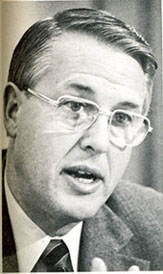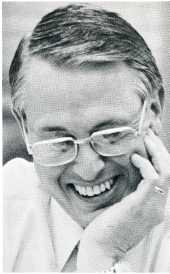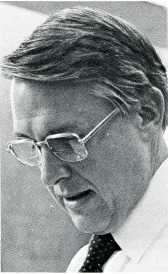 |
Home | Search | Browse | About IPO | Staff | Links |
 |
Home | Search | Browse | About IPO | Staff | Links |
   Ikenberry of Illinois: working to stop the 'slide' All of Illinois' public universities have suffered reductions in personnel and budgets in recent months. At the state's largest university, these cuts have created problems in morale and credibility, caused distinguished faculty to leave for higher salaries and jeopardized the reputations of key departments. Stanley O. Ikenberry, president of the University of Illinois since 1979, is working to "arrest the slide" and help the university restore its spirit, reputation and budget growth STANLEY O. Ikenberry, president of the University of Illinois, grew up in the home of a college president, but his boyhood experiences did not prepare him for the tough task he faces today. As the son of the president of Shepherd College, Shepherdstown, W. Va., Ikenberry recalls those days beginning in 1947 and continuing through the 1950s at the time when the campus was expanding, enrollments were rising and the budget was increasing. But now in his fourth year as UI president, Ikenberry is leading the battle to preserve the university as one of the premiere campuses in the nation in the wake of budget problems. "My main concern is to arrest the slide," he emphasized. His predecessor, John Corbally, warned in his final days as president in 1979 that the University of Illinois was in the initial stage of deterioration after enjoying, like most other campuses across the nation, expansions in programs, faculty and funds during the 1950s and 1960s. Yes, the university budget was continuing to grow during the 1970s. State funding for the UI had risen 87 percent in the last 10 years. Salaries of professors and other staff members were up 86 percent during the same period. But the cost of living has boomed 141 percent over the decade. Budget increases have not kept pace with inflation, and the most stunning statistic is that the university's energy costs have soared 1,500 percent over the last 10 years. But conservation efforts have reduced the overall increase to a mere 1,000 percent as the energy budget has increased from $3 million to $30 million. April 1983 | Illinois Issues | 5 Signs of erosion are readily visible on both the Urbana-Champaign and Chicago campuses, but probably the most significant signs are those which cannot be seen by a tour of facilities but are found among the internal correspondence swirling about faculty and administrative offices.
University officials, starting with Ikenberry and continuing with other top administrators, deans and department heads with increasing alarm fear an exodus of outstanding professors and an inability to recruit talented assistant professors who will develop into "stars." "That is the crux of the issue," Ikenberry emphasized. What may not be widely understood by the public, he explained, is that a university requires years, if not decades, to build a great faculty as the UI now enjoys. But it only takes several years for that greatness to crumble if top faculty members leave from various departments.
The UI Urbana-Champaign campus is regarded as the best place in the nation to train accountants. But a faculty member who resigned from that department to take a higher-paying job on another campus, told an administrator in a letter, "Illinois is rapidly gaining a reputation among other major universities as a university that is unwilling to make the necessary reallocations to maintain a high quality faculty. If this trend continues, the department will become viewed as fertile recruiting grounds by other universities." During the last six months of 1982, 13 faculty members of the Physics Department, also rated one of the best in the United States, were offered jobs on other campuses and in private industry. In a letter, one administrator referred to his hours of conversation with an assistant professor weighing an offer from the University of California who struggled with such questions as, "Does the State of Illinois, governor or legislature, show any evidence of changing the low priority given to the University of Illinois?" The Electrical Engineering Department is rated as one of the top four among American universities. But George W. Swenson Jr., department head, said that to get six new faculty members in the last three years, he had to make 60 offers. "We have so little to offer potential faculty other than the opportunity to work with outstanding colleagues and outstanding graduate students," Swenson wrote to a superior. "So far these factors have served us well, but unless these advantages can be complemented with adequate salaries, reasonable teaching conditions, and an atmosphere of optimism, we cannot hope to maintain our reputation as a top-flight department." William O'Brien, an electrical engineering professor, knows what lack of "reasonable teaching conditions" means. Three years ago, he taught a beginning course in circuits and had 30 students. For the spring 1983 term, he has 300 for the same class. The number of sections, or classes, offered for the circuits course, has been slashed from eight to two, and class size skyrocketed because the budget squeeze means not enough faculty members can be hired. Because the UI Urbana-Champaign campus was well built up years ago, two-thirds of its space is more than 50 years old. "Our chemistry labs are vintage 1916 and are the worst in the Big Ten," said Theodore L. Brown, vice chancellor for research and dean of the Graduate College. Chemistry is another UI department that is among the best in the nation, and its professors not only struggle with archaic facilities but also store some of their equipment in corridors because of space problems. The campus has a $5 million painting backlog, but its response last January was to fire 17 painters with up to 18 years of experience and declare a freeze on all interior painting through June. In a laboratory, Robert A. White, professor of mechanical engineering, mused, "Time is passing us by." He and his students use 1920 equipment for auto pollution research, including a piece of apparatus with huge levers that seems straight out of Frankenstein's laboratory and finally was scheduled to be replaced by the end of the term this June. These are some of the manifestations of the "slide" that Ikenberry wants to stop. He told the Illinois Board of Higher Education last January: "Illinois is at the crossroads facing decisions that ultimately could change the very character of our state. The central question is, will Illinois, the fourth largest state with a per capita income higher than 44 of the 50 states, build toward solid, long-term economic recovery by using its greatest single asset — its strong universities — as the bridge, or will Illinois allow the current downward spiral to continue?" April 1983 | Illinois Issues | 6
He also said: "If a strong system of higher education is among the top needs of Illinois, our public universities cannot continue to be at the bottom among funding priorities. Cuts in state support are harmful. They harm academic quality; they cause universities to lose their top faculty members; equipment becomes outmoded; library collections suffer; classes are cancelled; programs are cut; opportunities are lost; and ultimately, students and all the people of Illinois are the losers." Illinois is "dead last," 50th among the 50 states, in the percentage of increased money for higher education during the last 10 years, Ikenberry said. He emphasized that Illinois is below the national average among the states in state personal income tax, corporate income tax, sales tax and motor fuel tax. "The people of Illinois are prepared to be an average tax state," he said. Although roads, public transportation, and health are also strong competitors for new tax dollars, Ikenberry, buttressing his case for education to get a large share of any new revenue, emphasized: "Illinois must put its dollars where its future is." If higher education is indeed the state's top priority, Ikenberry said: "With this action, we can maintain our top rankings in the basic disciplines, in science, technology and the professions; without it, we will slide. "With it, we can maintain our competitive position [for faculty members]; without it, we will yield to more aggressive states. "With it, the university can give leadership to strengthening the quality of elementary and secondary education in Illinois; without it, we will continue to spend all our energies balancing the budget. "With it, we can assist industry in Illinois through programs of continuing education and research; we can strengthen our foreign languages programs; we can support essential basic research efforts; we can forge cooperative relationships with industry; we can retain our top faculty members; modernize equipment; renovate laboratories; and strengthen our library. "We can make it known that Illinois is determined to be at the front ranks." Though the budget issue is the most serious problem Ikenberry has faced as University of Illinois president, it has not been the one gaining the most publicity. In his first year in 1980, Ikenberry faced a vexing athletic question. The Big Ten denied a year of eligibility to the UI star football quarterback, Dave Wilson. While at a California junior college, Wilson was injured on the first play of the first game of the season, but the Big Ten ruled that it counted as one year in his college career. Wilson filed suit against the university and the Big Ten, and a court held he was entitled to another year of eligibility. Subsequently, the Big Ten wanted to impose stiff sanctions against the UI including three years on probation, a three-year loss of television revenue and bowl receipts and a three-year ban on post-season athletic competition. Cries of "let's get out of the Big Ten" rose from supporters of the Illinois athletic program. But Ikenberry, with his usual mild-mannered style, worked to reduce the penalties. "It would have been easier to deal with the university presidents," he said. But it was a committee of faculty members, one from each Big Ten school, that was empowered to act. "I finally worked it out with nine independent thinking professors," he recalled. "It was a communications problem. They were doubting the integrity of the university and the university was doubting the integrity of the Big Ten." April 1983 | Illinois Issues | 7
The penalties were reduced from three to one years in each area. Ikenberry, reflecting on his role in the Wilson matter, said, "I did not want to go down in history as the president who led the university out of the Big Ten." So far he has gone down in history as the youngest University of Illinois president, assuming the position at the age of 44. But Ikenberry enjoyed a meteoric rise in higher education. Born in Lamar, Colo., when his father was the local superintendent of schools, Ikenberry moved with his family to West Virginia. His father was academic dean at Salem College before becoming president of Shepherd College. Reared primarily on a college campus, Ikenberry from his early days wanted to be a university faculty member. He graduated from Shepherd College, majoring in history, then received his master's and doctor's degree at the age of 24 from Michigan State University in educational and social psychology. He stayed on as a faculty member at Michigan State for two years, then went to the University of West Virginia. At the age of 29, he was appointed dean of the College of Human Resources at West Virginia. In 1969, Ikenberry was a visiting professor at Penn State University, then joined the faculty a year later as professor of education research. In 1971, he guided the Pennsylvania statewide plan for higher education and in the same year was named senior vice president at Penn State. Ikenberry was named president of the University of Illinois in 1979. A screening committee considered 300 candidates and narrowed the field to seven finalists, who were interviewed by UI trustees. "We had all distinguished people," said William D. Forsyth Jr., trustees board chairman. "We only had one who was supported unanimously by the board — Stan Ikenberry."
Forsyth said the university was not just getting a president, but it was getting "a team." Part of the reason he favored Ikenberry was because of his wife, Judy. "It is extremely important to have a first lady who is supportive and gracious," Forsyth said. Trustees agree that Judy Ikenberry is a woman who works tirelessly for the university, though not required to do so, as a hostess and in innumerable public appearances. During the 1970s, the UI had a president, John Corbally, who was regarded as among the very best of university administrators in the nation. When Corbally declared his intention to step down, there was widespread concern whether trustees would find anyone in his league. Jane Hayes Rader, a university trustee during the 1970s, said the UI was "blessed" by having Corbally as its president. She doubted whether it would fare well without him, but after Ikenberry was named to succeed him, she said, "We have been blessed again." Nina Shepherd, a current trustee, said of Ikenberry: "He's very energetic, quick-witted, articulate, warm and persuasive. He's open to various points of view and builds a consensus. He represents the UI to the public at a very high level. He has the unusual combination of style and substance. Most people have one or the other, but not both. He doesn't like confrontation. His strength may lie in the fact he may be able to bring consensus on the retrenchment problem. He will have a chance to make it less painful." The complex University of Illinois has scores and scores of issues, but it's not Ikenberry's administrative style to get involved in all. "I tend to be a problem solver," he said. "I don't spend a great deal of time behind the desk shuffling papers and managing the day-to-day bureaucracy. On any day, I concentrate my energies on two to six key problems instead of the university's hundreds of problems." Many issues spin out of the overall financial problem. Engineering continues to be an increasingly popular field of study, so much that the UI now takes students who average in the top 2½ percent of their high school graduating classes. But the College of Engineering also faces severe space and equipment problems. After studying the problem and meeting with other administrators, Ikenberry recommended an extra $6 million for engineering to hire new professors and update equipment. Leisure time is limited, but during summers Ikenberry likes to take his sailboat to a nearby lake. ("Champaign is one of the great seaports of the country," he says with his characteristic dry humor.) In college, he sang in quartets, though now his singing is confined to the shower. But Ikenberry said among his most cherished times of leisure are those walks with his wife, Judy, when the two stride from the huge President's House on the edge of campus and stroll past the extensive nearby university flower beds and the farmland that create the warm atmosphere of serenity.□ Casey Banas is education writer for the Chicago Tribune. He has been a Tribune staff member for nearly 24 years and started covering education in 1964. April 1983 | Illinois Issues | 8 |
|
|